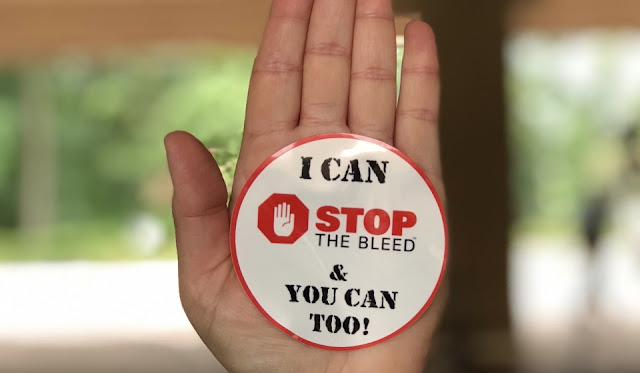New First Aid for Severe Trauma Training Can Help High Schoolers ‘Stop the Bleed’
By Sarah Marshall
Traumatic injuries -- like those sustained in car crashes or falls -- are what kill the most people between ages one and 44 in the U.S., even more than cancer, HIV, or the flu. In fact, a person can die from blood loss in just a few minutes. While these statistics likely won’t change overnight, training the public to treat injuries offers hope during an emergency, says Dr. Craig Goolsby, science director of USU’s National Center for Disaster Medicine and Public Health (NCDMPH).
“We want people to be ready when a tragedy occurs,” Goolsby said. “We’re trying to get as many people as possible to learn how to treat life-threatening injuries.”
For the past several years, Goolsby and his team at USU have been leaders in the national “Stop the Bleed” campaign, launched by the White House in 2015. The public-private effort encourages bystanders to become trained, equipped, and empowered to help in a bleeding emergency before first responders arrive. Over the last few years, Goolsby and USU’s NCDMPH have focused their efforts on this campaign, in particular, on researching the most effective ways to educate people on how to “Stop the Bleed” and how to quickly take action when an emergency happens, potentially saving the life of a loved one, friend, or even a stranger in a public space. They’ve published several studies looking at which teaching methods are most effective at helping learners absorb this information -- online, in person, “just in time” training,” or a combination of those modalities. They’ve also been developing smarter and more intuitive devices that can help facilitate bleeding control.
They’re also working on designing new education programs that are identified for specific learner populations, such as high school students, who haven’t yet been targeted as robustly with this information, Goolsby said. In collaboration with the American Red Cross and with funding from the Department of Homeland Security, NCDMPH has developed the first national Stop the Bleed course designed specifically for high schoolers, called First Aid for Severe Trauma, or FAST. This course and its digital materials, which will soon be offered at no cost to high school students nationwide under the age of 19, teaches how to stop bleeding after an injury.
FAST is also designed to be empowering, and straightforward. High schoolers will learn how to recognize that a bleeding emergency exists, and what action to take, i.e. applying pressure or using a tourniquet, while keeping safe in an emergency or violent situation. It also teaches them how to communicate with others at the scene and with emergency dispatchers.
It’s really beneficial to reach this population of high schoolers because they can in turn influence others in understanding these lessons, Goolsby added.
“There are willing learners at all ages, but children in particular are highly willing to learn and highly susceptible to learning new lessons,” he said.
Another advantage of teaching high school students is not having to overcome incorrect information that has been imparted on them. For example, previous generations might remember being taught to never use a tourniquet for any reason, but it’s now known that’s not correct. High schoolers, on the other hand, likely haven’t heard that before, and don’t have to overcome that negative lesson.
| High school students at a 2019 conference in Orlando, Florida practice using a tourniquet after watching a web-based tutorial on how to "Stop the Bleed." (USU photo by Sarah Marshall) |
“We also know that by teaching young people, there tends to be a multiplier effect,” Goolsby said. “They go home and tell their parents what they learned, as well as their friends and others. Teaching one high school student can result in more than one person learning important lessons through this sharing process.”
While Goolsby emphasizes that preventing injuries is critically important, accidents will continue to occur and people need to know how to respond. He envisions a world in which people know how to save lives by stopping life-threatening bleeding.
“Combining widespread education with access to effective tools (like tourniquets), is the best way to reach our goal,” he said.
Goolsby said his interest in this area piqued after serving two tours in Iraq as an Air Force emergency physician, treating injured service members on the battlefield. Many of those who came into his care were badly wounded, but yet they were alive. Despite being in an austere, hostile environment, these service members were being kept alive because their fellow troops knew how to take action to stop bleeding thanks to the military’s Tactical Combat Casualty Care training. These life-saving lessons were brought from the battlefield and are now being applied to the next generation in this country.
“It’s very rewarding to share simple lessons that can directly impact people’s lives,” Goolsby said. “If people can use these lessons to save lives, that’s just awesome.”
For more information on Stop the Bleed, visit: https://stopthebleed.usuhs.edu/.
For information on the FAST program, visit: https://www.dhs.gov/science-and-technology/first-aid-severe-trauma.







